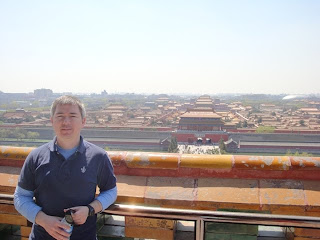Friday was 'Sports Day' at BLCU - an academic holiday - so an Aussie mate and I decided to go to Tiananmen Square to view Chairman Mao's body. We figured that since it wasn't a weekend or a holiday, the line might be shorter than the last time I tried to see Mao.
Something brought Beijing people out in droves - it must have been the nice weather. The line to get into Mao's mausoleum was actually longer than the last time I was there. Unbelievably longer … so long that we couldn't even find the end of the line! So, we decided to head north to the Forbidden City and beyond.
It was good to go back to the Forbidden City because I was able to make some new observations and get some different pictures, including a couple of cool statues of dragons and a statue of a turtle.
The Forbidden City is very grand in scale and the artisan work on the buildings that have been restored is very impressive. I was surprised, however, that many of the most popular buildings haven't had the art work restored. There was also a bit of irony with the crowds at 'The Hall of Supreme Harmony' and 'The Hall of Preserving Harmony'. There was some serious pushing and shoving going on, so I couldn't even get close enough to get any pictures.
Just north of the Forbidden City is 景山公园 (Jingshan Park), which overlooks the Forbidden City as well as the rest of Beijing. It is a well-manicured park, built around a huge hill made out of the material excavated to create the moat around the Forbidden City. It is the most pleasant place I've been in Beijing. I've included a picture of me standing on the hill with a good view of the Forbidden City in the background.
After that, we wandered around some of the small alleys around the park and eventually made our way to 雍和宫 (Yonghegong) – the Tibetan area of town. We were there just long enough to eat some fantastic prawns made with spicy Tibetan sauce and some spicy Tibetan beef.
After all of this, we made our way back to the university. We were too tired to see the Buddhist temple at Yonghegong. But don't worry, a visit there is also on my agenda!
再见!
-786876.JPG)












